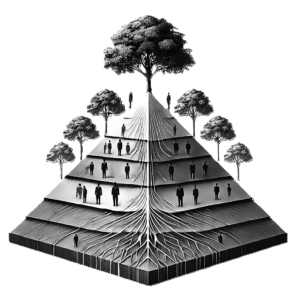Society loves a good dream: “Work hard, hustle, and you’ll reach the top!” But here’s the raw, unfiltered truth: not everyone is meant to be a leader. Leadership isn’t about titles or power—it’s about grit, responsibility, and vision. And let’s be honest: most people either don’t have it or don’t want it.
And that’s okay. The workplace doesn’t need everyone fighting to be at the top. It needs people who understand their unique value. The workplace is both an ecosystem and a pyramid—two systems that explain why every role matters and why the peak must remain small.
The Workforce Ecosystem: Why Every Role Matters
Picture the workforce metaphorically as an ecosystem. In nature, every part of the system plays a crucial role. The roots anchor the structure, the trunk and branches connect everything, and the canopy reaches upward, providing growth and direction.
At the foundation of this ecosystem are the essential roles: janitors, delivery drivers, grocery clerks, and factory workers. These are the roots—grounding and stabilizing everything above them. They might not be glamorous, but without them, nothing functions.

As you move up, you find the branches—mid-level managers and specialists who bridge the gap between vision and execution. And then, at the top, is the canopy: the executives, visionaries, and leaders who guide the system.
The roots stabilize, the branches connect, and the canopy leads. Every role is indispensable, and not everyone is meant—or needed—to climb to the top of the tree.
Ecosystem Meets Pyramid: The Symbiotic Relationship
The workforce is both an ecosystem and a pyramid—interconnected and hierarchical. The ecosystem explains why the pyramid exists, and the pyramid reminds us that not everyone can or should climb to the top.
During the COVID-19 pandemic, this relationship became glaringly obvious. Society didn’t run on the backs of CEOs or billionaires—it ran on delivery drivers, healthcare workers, grocery clerks, and janitors. They were the roots and the foundation, holding up the pyramid while others scrambled to adapt. At the same time, leaders at the top had to make critical decisions that would shape entire industries and save lives. The system only worked because every layer played its part.
Signs Leadership Isn’t for You
If you’re reading this and feeling defensive—thinking, “How dare someone say I’m not cut out for leadership!”—ask yourself why. Leadership requires emotional regulation, thick skin, and the ability to separate personal feelings from professional decisions. If the thought of not being at the top feels like an insult, that reaction says something about your readiness.
Final Thoughts: Own Your Role
Not everyone is meant to lead, and that’s not a flaw—it’s reality. Success isn’t about the title you hold; it’s about owning your role and excelling in it. Roots, branches, canopy—they’re all vital. The system thrives because each part fulfills its purpose.